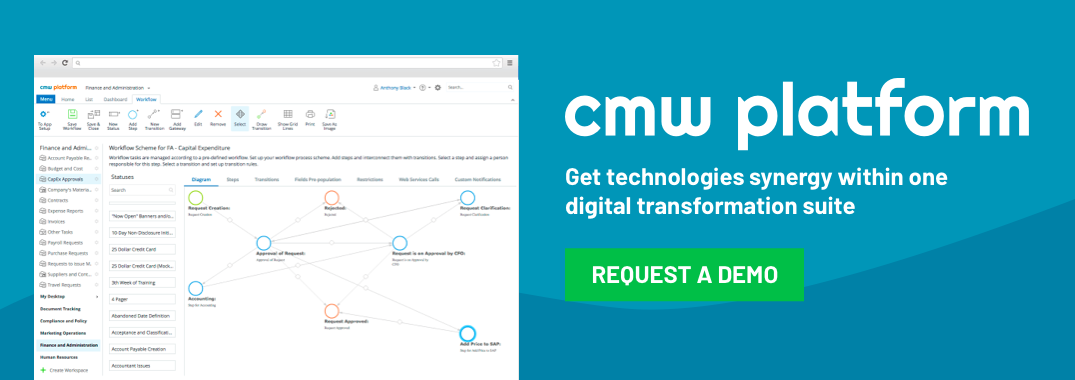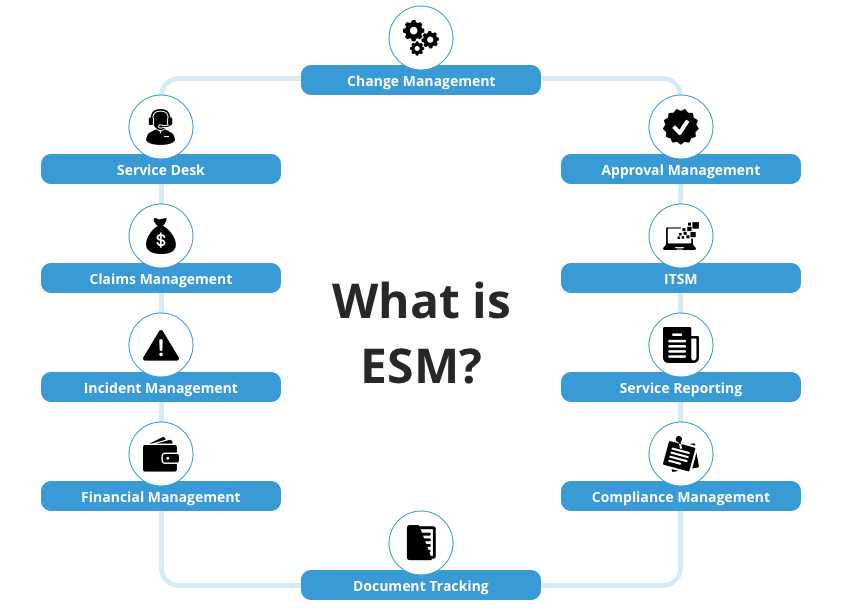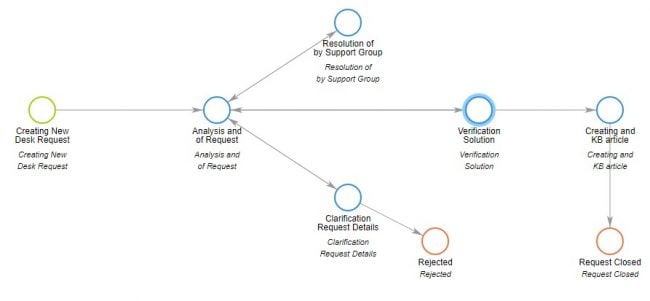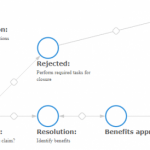What is ESM? When ITSM Spreads in Other Departments
April 6, 2025
Navigating the world of businss software solutions, especially those related to IT and service management, often involves a confusing array of acronyms. You’ve likely encountered terms like ITSM and, increasingly, ESM.
If you’re wondering what is ESM, what does ESM stand for, or the core ESM meaning, you’re in the right place. This guide unpacks the ESM definition, explains its critical role in modern US businesses for 2025, and explores how it leverages service management itsm principles to drive value far beyond the IT department

Table of Contents
Deciphering the Acronym: What Does ESM Mean?
Let’s start with the basics. The ESM acronym stands for Enterprise Service Management.
- ESM Definition: At its heart, ESM (Enterprise Service Management) is the practice of applying IT Service Management (ITSM) principles and capabilities to other business areas (outside of traditional IT) to improve performance, efficiency, service delivery, and the employee experience. The meaning of esm fundamentally revolves around extending service excellence across the organization.
- Core Idea: ESM means taking the successful models used to manage IT services – think standardized processes, service catalogs, self-service portals, and workflow automation – and extending them to departments like Human Resources (HR), Facilities, Finance, Legal, Marketing, and Customer Service to improve service across the board. This addresses the core esm meaning business context.
- ESM Full Form: Enterprise Service Management.
- What is an ESM System? An ESM system typically refers to the combination of strategy, processes, and technology (the ESM platform or ESM software) used to implement and manage services across the enterprise. The esm system meaning encompasses this holistic approach to how an organization delivers services.

So, if someone asks whats esm, asks what is a esm, or asks you to define esm, think “ITSM principles applied enterprise-wide for better service delivery.” The esm abbreviation simply shortens this concept. E S M isn’t just a buzzword; it’s a strategic approach vital for organizational efficiency. Answering “e.s.m meaning?” involves understanding this strategic extension.
ESM vs. ITSM: Understanding the Relationship
It’s crucial to understand the connection and distinction between ITSM and ESM:
- ITSM (IT Service Management): Focuses specifically on how IT teams manage the end-to-end delivery of IT services to the business. This includes planning, designing, delivering, operating, and controlling IT services using frameworks like ITIL.
- ESM (Enterprise Service Management): Stands for extending those same proven ITSM principles, practices, and often technologies (like the service desk concept, service requests management, and knowledge bases) to manage service delivery in non-IT business functions. ESM builds upon the foundation and successes laid by ITSM. Essentially, esm stand for applying a service-oriented mindset universally.
- SSM (Shared Service Management): While sometimes mentioned alongside ESM, SSM typically refers to consolidating specific administrative functions (like HR payroll or Finance accounts payable) into a centralized unit to serve multiple parts of the organization, primarily for cost efficiency. ESM often implies a broader, technology-enabled application of service management methodologies across various departments to improve service quality and user experience, not just consolidation.
Think of it this way: ITSM is the specialized discipline for IT service excellence; ESM is the strategic application of its successful elements across the entire enterprise fabric.
Why is ESM a Critical Strategy for US Businesses in 2025?
The adoption of ESM strategies isn’t just a trend; it’s driven by tangible business needs crucial for success in the competitive 2025 US market:
- Meeting Expectations in the Age of Digital Transformation: As organizations accelerate their digital transformation, employees and internal customers expect seamless, consumer-grade service experiences across all interactions, mirroring their experiences outside of work. ESM helps standardize service delivery to consistently meet these high expectations.
- Elevating the Employee Experience (EX): Clunky, manual processes for common requests (e.g., HR onboarding paperwork, facilities repair requests, finance approvals) lead to employee frustration, wasted time, and lower productivity. ESM streamlines these interactions via user-friendly service portals and automated workflows, significantly boosting the employee experience and overall morale.
- Driving Operational Efficiency and Cost Reduction: Standardizing processes across departments, automating routine workflows, and empowering users with self-service options via an ESM platform drastically reduces manual effort, minimizes errors, accelerates resolution times, and ultimately lowers the cost of service delivery.
- Boosting Workforce Productivity: When employees can easily find information (e.g., HR policies, facility procedures) and request services through a centralized service catalog and intuitive service portal, they spend less time navigating organizational bureaucracy and more time focused on their core, value-adding responsibilities, improving day to day effectiveness.
- Gaining Visibility and Enabling Data-Driven Decisions: ESM provides managers and leadership with much-needed visibility into service demand, team performance, potential bottlenecks, and resource utilization across various business functions. This data enables informed decision-making regarding process optimization and resource allocation.
- Effectively Supporting Hybrid & Remote Work Models: In a world where hybrid and remote work are prevalent, having centralized, digital access to services and standardized, location-independent workflows is essential for maintaining productivity and supporting a distributed workforce.
ESM in Action: Real-World Examples Beyond IT
To truly grasp what is ESM?, consider how its principles and tools are applied in non-IT departments:
- Human Resources (HR): Implementing workflows for employee onboarding/offboarding, managing benefits enrollment/inquiries, processing leave service requests, handling payroll questions, and providing easy access to HR policies via a self-service service portal.
- Facilities Management: Streamlining requests for building maintenance or repairs, managing meeting room bookings, handling office supply orders, coordinating office moves, and tracking facility assets.
- Finance & Accounting: Automating purchase order approvals, managing expense report submissions and approvals, handling vendor inquiries, and streamlining client billing processes.
- Legal: Managing contract review requests and approvals, tracking compliance tasks, handling requests for legal advice, and providing access to standardized legal document templates.
- Customer Service (Internal Support): While external customer service often uses CRM, ESM can manage internal processes supporting agents, handle escalations requiring cross-departmental input, or manage internal service requests from support teams.
- Marketing: Managing requests for new marketing collateral or website updates, coordinating event logistics, processing budget requests, and managing campaign approvals.
Key Benefits of Implementing an ESM Strategy
Adopting enterprise service management (ESM) translates into significant, measurable advantages for the organization:
- Improved and Standardized Service Delivery: Ensures consistent, faster, and more reliable delivery of internal services across all participating departments, leading to a better internal customer experience. This is core to improving service delivery.
- Increased Operational Efficiency: Automation of routine tasks and standardization of workflows reduce manual effort, eliminate redundant activities, speed up processes, and free up staff for more strategic work.
- Reduced Operational Costs: Lower service delivery costs achieved through automation, increased self-service adoption, optimized resource allocation, and reduced administrative overhead.
- Enhanced Employee Productivity & Satisfaction: Easier access to necessary services and information through a unified service portal empowers employees, reduces frustration associated with internal processes, and demonstrably improves the employee experience and morale.
- Greater Cross-Departmental Visibility and Reporting: A centralized ESM system provides valuable insights into service performance metrics, demand patterns, bottlenecks, and costs across the enterprise, enabling better oversight and data-driven improvements.
- Stronger Compliance and Governance: Standardized, documented processes managed through an ESM platform make it easier to ensure adherence to internal policies, industry regulations, and audit requirements.
- Improved Scalability and Agility: ESM software typically allows organizations to easily scale their service management practices to accommodate business growth, onboard new departments, or adapt to changing service needs more quickly.
 An example of service management workflow created in CMW Tracker with drag’n’drop simplicity.
An example of service management workflow created in CMW Tracker with drag’n’drop simplicity.Core Components for Successful ESM Implementation in 2025
Successfully implementing enterprise service management esm requires a structured approach focusing on several key components:
- Clear ESM Strategy & Vision: Define the specific business goals, scope (which departments/services to include initially), and a phased roadmap for your ESM initiative. Address internal research questions regarding current pain points and desired outcomes. Establish clear ownership and governance.
- Executive Sponsorship & Change Management: Secure visible support from senior leadership to champion the initiative. Actively manage the organizational change involved, emphasizing the benefits for employees and departments to encourage adoption.
- Selecting the Right ESM Platform / Software: Choose appropriate enterprise service management software that aligns with your needs and technical capabilities. Evaluate various software solutions based on factors like workflow automation strength, ease of use (for both admins and end-users), integration capabilities, reporting features, and scalability. Platforms like ServiceNow, Jira Service Management, Ivanti, Freshservice, and others offer robust ESM capabilities (mentioning examples provides context). Customizable workflow platforms can also serve as the technical backbone for an ESM system.
- Defining Services & Building the Service Catalog: Work with participating departments to clearly define the services they offer to other parts of the business. Document these services, including descriptions, target users, request procedures, and expected delivery times (where applicable), in a user-friendly, centralized service catalog.
- Standardizing Key Processes: Identify, map, and standardize core service management processes that will be used across departments, such as request fulfillment (handling service requests), incident management (for non-IT disruptions), knowledge management, and potentially change management for shared services.
- Designing an Intuitive User Experience: The service portal is the primary interface for employees. Design it to be intuitive, easy to navigate, searchable, and accessible, ensuring a positive employee experience.
- Phased Rollout & Continuous Improvement: Start with a pilot project involving one or two departments or a set of high-impact services. Learn from the pilot, gather feedback, refine processes and configurations, and then incrementally roll out ESM to other areas. Establish mechanisms for ongoing monitoring and improvement.
Choosing the Right ESM Software / Platform: Key Considerations
Selecting the technology underpinning your ESM system is a critical decision. When evaluating what is esm software options, look for:
- Robust Workflow Automation: The ability to easily design, automate, and manage complex, multi-step processes that may span multiple departments.
- Unified Service Catalog: A flexible and easy-to-manage catalog for defining, publishing, and organizing available services from various departments.
- Intuitive Self-Service Portal: A user-friendly, customizable portal where employees can easily find information, browse the catalog, submit service requests, and track their status.
- Reporting & Analytics Dashboards: Tools to measure key performance indicators (KPIs), track service levels, identify bottlenecks, and gain insights into service trends across the enterprise.
- Strong Integration Capabilities: The ability to seamlessly integrate with other critical business systems (e.g., HRIS like Workday or SAP SuccessFactors, ERP systems, CRM, communication tools like Slack/Teams, IT monitoring tools). Check for pre-built connectors and API availability.
- Low-Code/No-Code Configuration: Features that empower department administrators or “citizen developers” to configure forms, workflows, and reports with minimal reliance on specialized IT resources.
- Integrated Knowledge Management: A built-in or tightly integrated knowledge base for creating, managing, and surfacing FAQs, how-to guides, and solutions to promote self-help and deflect requests.
- Mobile Accessibility: Native mobile apps or responsive web portals to allow users and support staff to access services and manage tasks on the go.
ESM Trends Shaping 2025 and Beyond
The ESM landscape is dynamic and continues to evolve. Key trends influencing ESM strategies and platforms in 2025 include:
- AI-Powered Service Management: Artificial intelligence is becoming deeply embedded, powering intelligent chatbots and virtual agents for instant support and request deflection, enabling predictive analytics for anticipating service needs (e.g., staffing levels, potential issues), and driving intelligent automation of complex decision-making within workflows.
- Proactive and Predictive Service Delivery: A significant shift from purely reactive request fulfillment towards using data and AI to proactively identify potential issues (e.g., predicting facilities maintenance needs based on usage patterns) and offer solutions or interventions before users are even aware of a problem.
- Hyper-Personalization of the Employee Experience: ESM platforms are focusing more on tailoring the service portal and communications based on employee roles, location, department, and past interactions, creating a more relevant and engaging employee experience. Source: Analysis from firms like Gartner and Forrester highlighting EX as a key competitive differentiator.
- Democratization via Low-Code/No-Code: The continued growth of low-code/no-code capabilities empowers non-technical users within business departments (HR, Finance, etc.) to build, modify, and manage their own service workflows directly within the ESM system, increasing agility and reducing IT backlog.
- Sophisticated Analytics & Process Intelligence: Moving beyond basic dashboards to leverage advanced analytics and process mining tools to gain deeper, actionable insights into how services are actually being delivered, identify hidden inefficiencies, and drive data-backed continuous improving service delivery.
- Seamless Integration with Collaboration Hubs: Tighter, more functional integrations with popular collaboration platforms (Microsoft Teams, Slack) allowing employees to initiate service requests, receive updates, and grant approvals directly within the tools they use for their day to day work.
- Focus on Value Streams: Aligning ESM processes and metrics more closely with end-to-end business value streams, rather than just departmental silos, to better demonstrate impact on overall business outcomes.
Conclusion
In answering the question ‘what is ESM’, this piece has explored a lot of different aspects on it. It is a sure way of gaining a competitive edge over other companies that fail to see its merits and any company that does implement ESM will enjoy not only having a better technological edge but better growth margins and customer and employee satisfaction.
CMW Tracker delivers a full set of features for effective enterprise service management.



